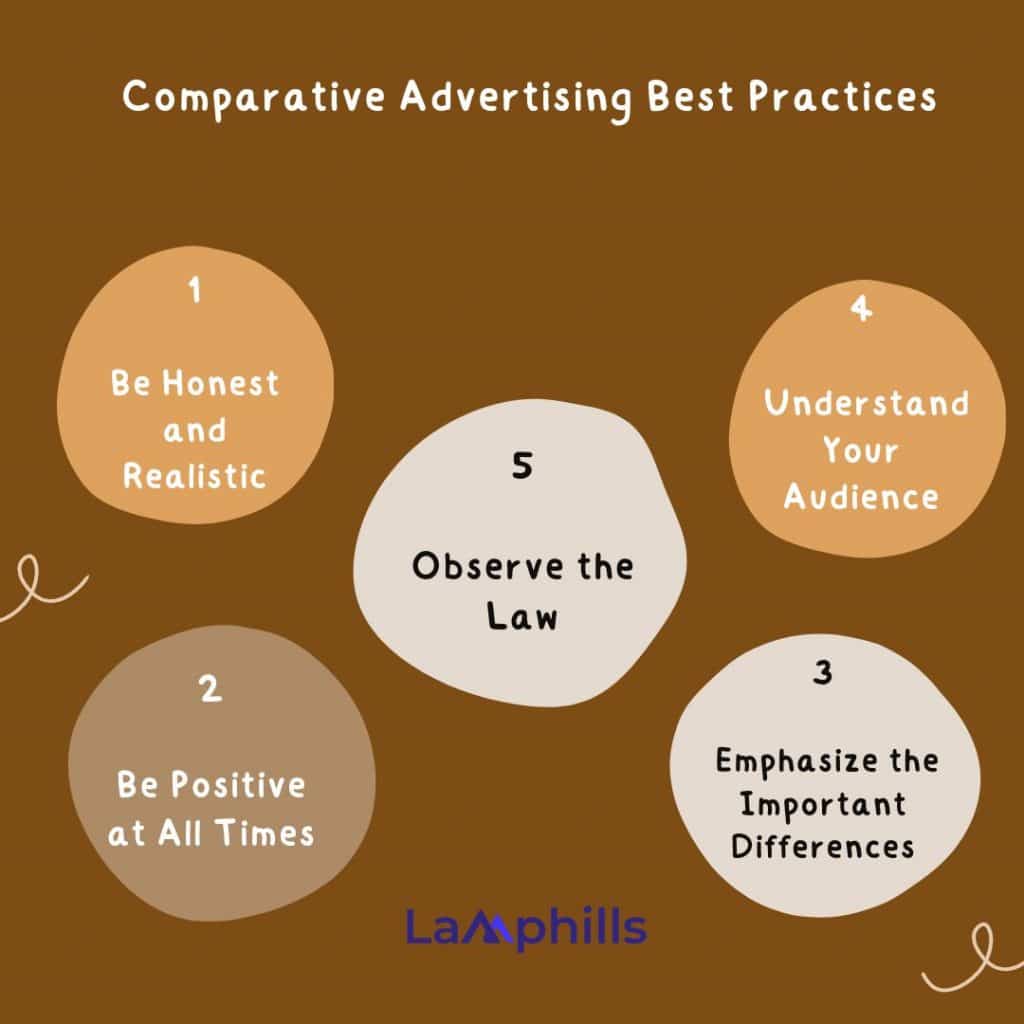As soon as I entered the competitive world of advertising, I understood that being unique required more than simply having the greatest product or service; it also required situating it in the eyes of customers. The use of comparative advertising was one of the most effective strategies I discovered along the way. Although it wasn’t something I had intended to use, I found myself looking everywhere to get attention as the competition grew more fierce. This article will describe my experience and provide example cases of how I used comparative advertising to outperform my rivals.
Key Points
- Comparative advertising highlights the advantages of a brand’s product by directly contrasting it with that of a competitor.
- Comparative advertising increases consumer decision-making, helps differentiate items, and raises brand exposure.
- Verifiable and accurate claims are necessary to prevent legal problems.
- Comparisons that are too aggressive may cause criticism and an increase in competition.
- A well-executed comparative advertising strategy can boost market share.
Overview
A company that uses comparative advertising portrays its products or services as superior to those of its competitors. The attributes of a company’s products may be printed side by side with those of its competitors as part of a comparative advertising campaign. Additionally, it might provide a cost or value comparison. The rival product is usually presented negatively.
The tone of comparative advertising can be either positive or negative, though negativity is more common. It can compare goods or services directly or indirectly. Comparisons can be made between one or more qualities.
A product or service is not the only thing that is promoted through comparative advertising. In political ads, it has been a standard practice for candidates to mention the precise actions they would not have taken if elected in place of the incumbent. Businesses that are launching new items frequently use this kind of advertising since it highlights the advantages of the new product over competing goods.
Also Read: The Complete Guide to Becoming an Advertising Manager
My Journey: Dealing with Serious Rivals
I had a product in a crowded market when I first started my business. It was stressful, I’ll be honest. There were larger businesses wherever I looked, with more devoted followings, more robust marketing budgets, and an apparent unbeatable market position. It was like pushing a heavy object uphill to get customers to notice me, even though I knew my idea had potential.
My product’s distinctive attributes were the main emphasis of my traditional advertisements, but nothing was really catching. There was little brand awareness, and sales were stagnant. It was during this crucial period that I discovered comparative advertising.
Finding Out About Comparative Marketing
Comparative advertising highlights the benefits of a brand’s product or service by directly contrasting it with that of a competitor. The hazards of this adventurous strategy include possible penalties and competitiveness. But when executed properly, it’s also really powerful.
I recall going to a marketing seminar where the speaker talked about well-known instances of comparison advertising. The Pepsi versus. Coca-Cola and the iconic Apple vs. PC advertisements were two that I found particularly memorable. It was fascinating how daring those businesses were to publicly compete with one another. It involved actively establishing themselves as the superior choice rather than merely displaying their product.
When I walked out of the session, I thought, “Why not us? Why not me? Although I was aware that my product was superior in several ways, I had not yet dared to compare it with any rival.
First Things First: Market Analysis
To begin using comparative advertising, I had to decide which competitors I wanted to use to evaluate my product. I concentrated on mid-tier competitors that were more in line with me but still had a larger client base rather than setting high targets or pursuing industry titans as Coca-Cola had done with Pepsi.
One of my competitors had a major flaw, according to my research: although they brag about their prices, customer reviews revealed that the quality of their goods varied. However, although being a little more costly, my product was routinely rated higher for quality and lifespan. This viewpoint was what I needed.
Campaign Creation: My First Comparative Advertisement
The next task after obtaining the ammunition was to create the advertisement. It has to be straightforward without being too combative, I realized. I didn’t want to appear aggressive or lose customers. My objective was straightforward: provide a concise, fact-based comparison that would enable them to make an informed choice.
The ad I made showed two side-by-side comparisons. On one side, I displayed the pricing of my rival’s product along with a list of typical problems that consumers had complained about, such as low material quality and short product life. Conversely, I emphasized my product’s improved build quality, longer lifespan, and positive customer feedback despite its increased price.
The slogan was “Select Quality That Lasts: Pay a Little More, Get a Lot More.” It wasn’t too severe, but it was clear and simple. The intention was to allow customers to make their own decisions without feeling forced or under pressure.
The Outcomes: Outperforming the Competition
That initial advertisement received an instant response. In just a few days, my website’s traffic grew by 42%, and the advertisement generated discussion on social media. People were drawn to the comparison’s originality. Additionally, my sales significantly increased—they doubled in just two months.
Above all, my brand became extremely well-known. Before the advertisement, I was simply another business attempting to establish itself. Following the advertisement, my product became recognized as a high-end product in the marketplace. They didn’t mind paying a little bit more because the advertisement clearly explained that they were receiving better value.
Despite considerable opposition from my rival (including an attempt to dispute the accusations), I had done my research. Every claim made in the advertisement was supported by data that could be verified, thus I was shielded from any legal problems.
Also Read: PR vs. Advertising: Which One Will Skyrocket Your Brand?
How to Leverage Comparative Advertising
Comparative advertising, in review, changed the game for my company. The method behind the comparison, however, was what made it successful, not just the comparison itself. Some important things I took away from that experience that can assist anyone wishing to use comparative advertising to their advantage are as follows:
#1. Be Aware of Your Rivals’ Weaknesses
Do your study before you ever consider comparing your product to a rival. What distinguishes their strong and weak points? In what ways is your product superior to theirs? In my situation, the quality of the goods was crucial. I was aware of my competitor’s pricing advantage, but I also knew that customers were annoyed by their poor quality. I took advantage of this in my ad.
#2. Instead of being aggressive, be confident
There’s a thin line between expressing your product’s superiority with confidence and coming out as unfriendly or too aggressive. Your comparative advertisement should have an educational tone rather than a hostile one. Instead of destroying my competitor’s product, I concentrated on emphasizing its benefits.
#3. Be Truthful and Fact-Based
Ensuring your comparative assertions are supported by facts is the key to staying out of trouble with the law and keeping your reputation. I conducted extensive research on both my goods and those of my competitors, as well as retrieved user reviews. I was shielded from prospective lawsuits because every claim in my advertisement could be supported by evidence.
#4. Track the Response and Make Adjustments
Following the release of a comparable advertisement, it’s critical to keep a careful eye on the reaction. Customers and rivals gave me comments, which I used to improve my strategy for upcoming advertisements. Be ready to change course if your advertisement is receiving unfavorable comments or isn’t taking off as you had intended.
#5. Identify Your Target Market
My target audience responded favorably to my comparative advertisement, which is one of the reasons it was so successful. I was aware that they prioritized quality over cost. The advertisement might not have been as successful if I had been aiming for a different audience, like budget-conscious shoppers. Understanding the values of your target audience is essential for effective comparative advertising.
Example of Comparative Advertising
The following are some well-known instances of how other firms have effectively employed comparative advertising to help you understand:
#1. Pepsi versus Coca-Cola
Pepsi began a series of advertisements that compared its product to Coca-Cola, frequently portraying itself as the more refreshing choice in blind taste testing. This was one of the most well-known comparison advertising conflicts in history.
#2. Domino’s vs. Subway
A comparison campaign was once started by Domino’s Pizza against Subway, stating that their sandwiches were of higher quality and contained more meat for the money. Subway responded with a defensive campaign when the bold approach paid off.
#3. The PC versus the Apple
Apple’s “Get a Mac” campaign is among the best examples of comparative advertising. The advertisements showed two individuals, one of whom stood in for a PC and the other for a Mac. The Mac was always presented as being more inventive, user-friendly, and adaptable.
Advantages of Comparative Advertising
The benefits of comparative advertising include the following:
#1. Enhanced Awareness
Making direct comparisons can attract buyers and raise awareness of your goods.
#2. Making Decisions with Consumers
Giving customers accurate comparisons helps them make well-informed judgments about what to buy.
#3. Increase in Market Share
Raising your product’s market share and sales might result from properly placing it versus rivals.
#4. Distinguishment
It draws attention to the special qualities of your product and its benefits over rivals.
The Negative Effects of Advertising Comparative
The drawbacks of comparative advertising include:
#1. Potential Legal Hazards
Fraudulent statements or misrepresentations may result in legal action or regulatory attention.
#2. Competitive Reactions
In response, rivals can release comparable ads, worsening the advertising battle.
#3. Observe Your Rivals
It can take focus away from highlighting the positive aspects of your own brand, which will make it less remembered.
#4. Backlash
Harsh comparisons could drive away customers or damage your brand’s reputation.
What Is Meant by Comparative Advertising?
A brand that uses comparative advertising highlights the benefits of its offering by directly contrasting it with a competitor’s product or service. To demonstrate why one product is better or more affordable, the comparison is straightforward. The trick is to highlight the distinctions in a way that persuades customers to pick the advertiser’s product over the rival’s.
What is the Law of Comparative Advertising?
In ads, the practice of directly contrasting a product or service with that of a rival is governed by rules known as the Comparative Advertising Rule. Comparative advertising is permitted in most countries, including the US, although there are strong regulations in place. Statements must be accurate, truthful, and not deceptive. Overly dramatic or inaccurate comparisons may result in legal problems or negative consumer reactions. Such advertisements are monitored by regulatory agencies such as the Federal Trade Commission (FTC) to guarantee compliance.
What are the Comparative Advertising Best Practices?
You can effectively use comparison advertising by following these guidelines. For comparison advertising, the following are some best practices:
#1. Be Honest and Realistic
Be certain that every claim is true and backed up by data.
#2. Be Positive at All Times
Refrain from using too hostile or negative language to avoid offending clients.
#3. Emphasize the Important Differences
Prioritize areas where your product excels.
#4. Understand Your Audience
Ensure that your message aligns with the values and aspirations of the audience you are targeting.
#5. Observe the Law
Understanding advertising laws will help you stay out of trouble with the law.

What Is an Example of Comparison Advertising?
I can recall the first time I was genuinely drawn in by a comparative advertisement. It was a classic Coca-Cola versus. Pepsi commercial. In a taste test, Pepsi gave participants both beverages without identifying which was which. The majority of those surveyed chose Pepsi because it tasted better. I became aware of the potential power of comparative advertising when you have faith in your product after seeing that.
In one instance, I aired an advertisement contrasting the longevity of my product with that of a rival. Although their product was less expensive, I demonstrated that mine lasted twice as long using actual customer reviews and data. It was modest but effective, and it unexpectedly increased my sales.
Is Comparative Advertising Legal?
Although most countries allow comparative advertising, there are strict rules to make sure the comparisons are accurate and not deceptive. Such advertisements’ claims must be fact-based and verified. In certain areas, making inflated or fraudulent promises may result in legal penalties or competition lawsuits. For instance, the Federal Trade Commission (FTC) in the US regulates whether comparable advertising is truthful.
When I initially thought about employing comparison advertising, I recall that my main worry was whether it was legal. Getting into trouble or getting into a big legal battle was the last thing I wanted. Fortunately, I discovered that some states do allow comparable advertising, but you must exercise caution. You must ensure that each statement you make is supported by substantial evidence.
Real customer feedback and independent studies were cited in my campaign comparing product durability. You are protected as long as you are truthful and your statements are verifiable. However, I also discovered that lying or misleading might result in legal action, particularly if a rival believes they have been unfairly represented.
What Is Competitive Advertising With an Example?
I had largely relied on competitive advertising before I tried comparative advertising. Here, you highlight the advantages of your product without making direct comparisons to competing ones. For instance, Nike doesn’t have to criticize rivals like Adidas or Reebok in its “Just Do It” advertisements. They highlight Nike’s unique selling points, which include inspiring others, pushing the envelope, and encouraging athleticism.
I’ve also executed similar campaigns in my own company. I used to advertise my product’s qualities, such as its quality and the attention I put into its creation, but I never mentioned any other companies. It was somewhat successful, but as I began using comparisons, I noticed a far more robust response.
Also Read: Advertising vs. Marketing: Which Should Your Business Focus On More?
What Are the Two Forms of Comparative Advertising?
Based on my personal experience, I’ve tried both approaches of comparative advertising.
#1. Direct Comparative Advertising
As Pepsi did with Coca-Cola, this is the time to specifically call out a rival. It’s challenging because you need to be certain and have strong evidence to support your statements, but I’ve done it a couple of times. For instance, I specifically mentioned another company when I compared the durability of my product to theirs. My statements were true therefore it worked, but you must exercise caution.
#2. Indirect Comparative Advertising
At times, this method seems a little safer. You simply refer to them as “other brands” or “leading competitors” rather than naming a specific rival. I’ve said something like, “Our product lasts twice as long as others on the market,” without mentioning specific names, more frequently. It conveys the point clearly and is less likely to result in legal issues.
Conclusion
Comparative advertising can be a very effective strategy for surpassing competitors when used correctly. I learned from my experience that it’s not enough to simply compare things; you also need to understand your market, identify the shortcomings of your competitors, and present your product as the superior choice in the eyes of customers. Although it was a risky move for my company, it paid off in ways I never would have thought possible. Sales increased, my brand became more well-known, and I became a market participant. I was able to get the edge I needed thanks to comparative advertising, and others can too with the correct approach. Don’t be afraid to draw comparisons if you want to stand out in a crowded market. Just make sure you approach it carefully, confidently, and with the facts constantly on your side.
Related Articles
- Guide to Becoming a Highly Effective Email Marketing Specialist
- Strategies of Customer Acquisition: Best 2024 Practices
- HOW TO MEASURE BRAND AWARENESS: Tips To Improve Your Brand Strategy
- Advertising Campaign: Definition, Types & Examples.
- What is Brand Advertising? How To Build Brand Awareness






